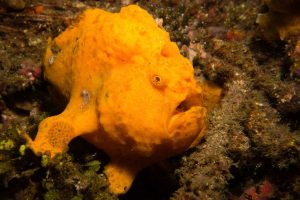
Frogfish
Frogfish, also known as anglerfish, are a unique group of fish belonging to the family Antennariidae. They are known for their unusual appearance, elaborate camouflage, and a specialized adaptation known as an illicium or “fishing rod.” Here are some interesting facts about frogfish:
Appearance: Frogfish have a stocky and round-shaped body with a large mouth and expandable stomach. They come in a variety of colors and patterns, including mottled, spotted, and striped, which help them blend with their surroundings. Some species have appendages or filaments resembling algae or sponges, enhancing their camouflage.
Camouflage and Hunting: Frogfish are masters of disguise. They have the ability to change their skin color and texture to match their environment, making them almost invisible to both prey and predators. They use their illicium, a modified dorsal fin spine, as a fishing rod with a lure-like esca at the end. By wiggling the esca, they attract unsuspecting prey, such as small fish or crustaceans, close enough for a quick strike.
Feeding Behavior: Frogfish are voracious predators. They are ambush hunters, patiently waiting for their prey to come within striking distance. Once a suitable prey item is within range, frogfish rapidly extend their mouth and create a powerful suction, engulfing their prey in a fraction of a second.
Habitat and Distribution: Frogfish are found in tropical and subtropical waters worldwide, predominantly in coral reefs, rocky areas, and sandy or muddy bottoms. They have a remarkable ability to blend with their surroundings, allowing them to reside in a variety of habitats.
Size and Lifespan: Frogfish species vary in size, ranging from a few centimeters to over 30 centimeters (1 to 12 inches) in length. Their lifespan is generally around 3 to 5 years, but some species can live longer in captivity.
Reproduction: Frogfish have unique reproductive behavior. Males are typically smaller than females and may attach themselves to the female’s body, fusing their tissues together. Females produce large, gelatinous egg masses, which they guard until hatching. After hatching, the juvenile frogfish drift in the ocean currents until they find suitable habitats.
Conservation Status: Frogfish populations are generally not assessed individually, but some species are at risk due to habitat destruction, pollution, and overfishing. Their reliance on healthy coral reef ecosystems makes them vulnerable to the impacts of climate change and ocean acidification. Conservation efforts aimed at protecting coral reefs and implementing sustainable fishing practices are crucial for their long-term survival.
Frogfish are fascinating creatures with their incredible camouflage and unique hunting strategy. Their ability to lure and capture prey using their illicium is a remarkable adaptation found in few other fish species. Observing these peculiar fish in their natural habitat is a treat for divers and underwater enthusiasts.